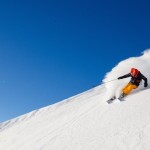 Have you ever felt tightness in different areas of your body was restricting your skiing? Have you noticed how it is easier to turn in one direction than in the other? It is not uncommon as humans are not truly symmetrical and we favour one side over the other. For example when waiting in a line you may be leaning over to one side instead of having your weight evenly distributed over both feet. Postural habit or old injuries have developed restrictions that prevent us from having a full range of motion. Of course it becomes more noticeable during sports like skiing and snowboarding, as our bodies are in continuous adjustment of position, in response to the different surfaces, inclines and changes of direction. As your centre of gravity is constantly changing while you ski, every muscle of your body, coordinated by your nervous system is used to keep your balance and to go down to the best of your ability.
Have you ever felt tightness in different areas of your body was restricting your skiing? Have you noticed how it is easier to turn in one direction than in the other? It is not uncommon as humans are not truly symmetrical and we favour one side over the other. For example when waiting in a line you may be leaning over to one side instead of having your weight evenly distributed over both feet. Postural habit or old injuries have developed restrictions that prevent us from having a full range of motion. Of course it becomes more noticeable during sports like skiing and snowboarding, as our bodies are in continuous adjustment of position, in response to the different surfaces, inclines and changes of direction. As your centre of gravity is constantly changing while you ski, every muscle of your body, coordinated by your nervous system is used to keep your balance and to go down to the best of your ability.
Skiing is like loosing balance without falling. It can be very graceful, yet sometimes a bit more awkward to watch. Of course that is related to many different factors, such as experience, age, fitness level and frequency and recency of practice. Beyond a preliminary fitness regimen that should start at least 3 months before the season, biomechanical factors, the way the different parts of your body move with each other, can determine how well you go down the slopes.
Skiing requires a complex succession of movements, and even if you think that your knees and your legs are doing most of them, your spine and pelvis are actually constantly under load demands and small imbalances can completely change the way you ski.
This article will simply explain the action of your pelvis, lumbar and thoracic spine during skiing and describe what commonly happens due to tightness and restriction in these areas. Then we will cover a few simple exercises to improve your skiing, decrease the risk of injury and increase the fun factor!
First and foremost, along with your knees and hips, your lumbar spine is acting like a spring and are under constant demand, especially if the terrain is uneven. Short hip flexor muscles (iliopsoas), weak core stabilizers (deep abdominal muscles and multifidus) and buttock muscles (gluteus maximus) generally result in an inefficient pelvis position and in a slump posture as the lower back (lumbar spine) is held in flexion. This greatly affects the shock absorption required when skiing bumpy terrain. Tip: keep good flexibility of your hip flexors by stretching and strengthen your core stabilisers and your gluteal muscles. Don’t forget your hamstrings that are commonly short.
Changing direction and turning require harmonious rotation of the trunk (thoracic cage). We commonly see in practice difference in range of motion when we compare thoracic left or right rotation. Commonly our patients can go further in one direction than in the other. It may or may not cause pain, however it generally results in a feeling of restriction when practicing a sport that requires rotations, be it skiing, surfing, golf or tennis. Nevertheless the thoracic spine is often restricted in extension; often the result of a poor posture or hours in front of the computer. Here again a slouched posture reduces your ability to turn your shoulders while skiing. Tip: Keep a good thoracic mobility through the year by doing rotation and extension exercises.
Now that seems quite simple and indeed it is. Let’s keep in mind that everyone is different and that the whole picture is way more complex: Even if we see common patterns of restriction in our daily practice we know that each individual is different and presents with a different body and a different story. While these tips and examples can help you with general mobility and flexibility, Osteopaths are trained in assessing and correcting specific and individual imbalances that can cause pain or lead to lack of motion and injuries. A pre season check up is always a good idea to make sure that your body is in balance and to hit the slopes finely tuned. Now let’s pray for some powder days! Let us help you get the most out of this season.
François Naef, Osteopath





